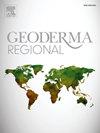Seasonal variation-dependent biochar impacts on coastal acid-sulfate soil in paddy fields and the consequences on rice growth and yield
IF 3.1
2区 农林科学
Q2 SOIL SCIENCE
引用次数: 0
Abstract
Utilizing eco-friendly and cost-effective amendments, like biochar produced from agricultural biomass wastes offers numerous benefits for ameliorating acid-sulfate soils in coastal regions. This study investigates seasonal variation and rice husk and longan biochar's impacts on soil properties, quality, and rice (Oryza sativa L.) growth and yield in acid-sulfate paddy fields during dry and rainy seasons. Five treatments (T) were tested: T1 (no biochar), T2 and T3 (10-tone and 20-tone rice-husk biochar ha−1), and T4 and T5 (10-tone and 20-tone longan biochar ha−1). Results showed that biochar improved soil properties with pH increasing by 3.2 % to 9.2 % and exchangeable Al decreasing by 7.7 % to 18.1 %, compared to T1, dependent on treatments and seasons. Soil quality index in biochar treatments increased by 30 %, 54 %, 26 %, and 16 % for T2, T3, T4, and T5, respectively, compared to T1 in the dry season. This season exhibited the highest grain weight (1.06 kg m−2) and total biomass (2.31 kg m−2) in T3, followed by T5, T2, T4, and T1. The rainy season benefits were less pronounced, likely due to leaching, suggesting more frequent applications may be necessary in high-rainfall regions. Liming effects and leaching in the rainy season were identified as primary mechanisms influencing soil quality and rice yield. Rice-husk biochar was more effective than longan biochar in mitigating soil constraints and enhancing rice yield. In short, biochar effectively ameliorates acid-sulfate soil constraints, improving rice yield and growth. However, rapidly diminishing effects during the rainy season necessitate further investigation for optimal application in high-rainfall regions.
取决于季节变化的生物炭对水田沿海酸性硫酸盐土壤的影响以及对水稻生长和产量的影响
利用生态友好型和具有成本效益的添加剂,如利用农业生物质废物生产的生物炭,可为改善沿海地区的酸性硫酸盐土壤带来诸多益处。本研究调查了季节变化以及稻壳和龙眼生物炭在旱季和雨季对酸性硫酸盐水稻田土壤性质、质量以及水稻(Oryza sativa L.)生长和产量的影响。测试了五个处理(T):T1(无生物炭),T2 和 T3(10 吨和 20 吨稻壳生物炭公顷-1),T4 和 T5(10 吨和 20 吨龙眼生物炭公顷-1)。结果表明,生物炭改善了土壤性质,与 T1 相比,pH 值提高了 3.2% 至 9.2%,可交换铝降低了 7.7% 至 18.1%,这取决于处理和季节。与旱季的 T1 相比,生物炭处理的 T2、T3、T4 和 T5 的土壤质量指数分别提高了 30%、54%、26% 和 16%。在这一季节,T3 的粒重(1.06 千克/平方米-2)和总生物量(2.31 千克/平方米-2)最高,其次是 T5、T2、T4 和 T1。雨季的效益不太明显,这可能是由于沥滤作用造成的,这表明在高降雨量地区可能需要更频繁地施用。雨季的限制效应和淋溶被认为是影响土壤质量和水稻产量的主要机制。在缓解土壤限制和提高水稻产量方面,稻壳生物炭比龙眼生物炭更有效。简而言之,生物炭能有效改善酸性硫酸盐土壤制约因素,提高水稻产量和生长。然而,生物炭的作用在雨季会迅速减弱,因此有必要进一步研究在高降雨量地区的最佳应用。
本文章由计算机程序翻译,如有差异,请以英文原文为准。
求助全文
约1分钟内获得全文
求助全文
来源期刊

Geoderma Regional
Agricultural and Biological Sciences-Soil Science
CiteScore
6.10
自引率
7.30%
发文量
122
审稿时长
76 days
期刊介绍:
Global issues require studies and solutions on national and regional levels. Geoderma Regional focuses on studies that increase understanding and advance our scientific knowledge of soils in all regions of the world. The journal embraces every aspect of soil science and welcomes reviews of regional progress.
 求助内容:
求助内容: 应助结果提醒方式:
应助结果提醒方式:


